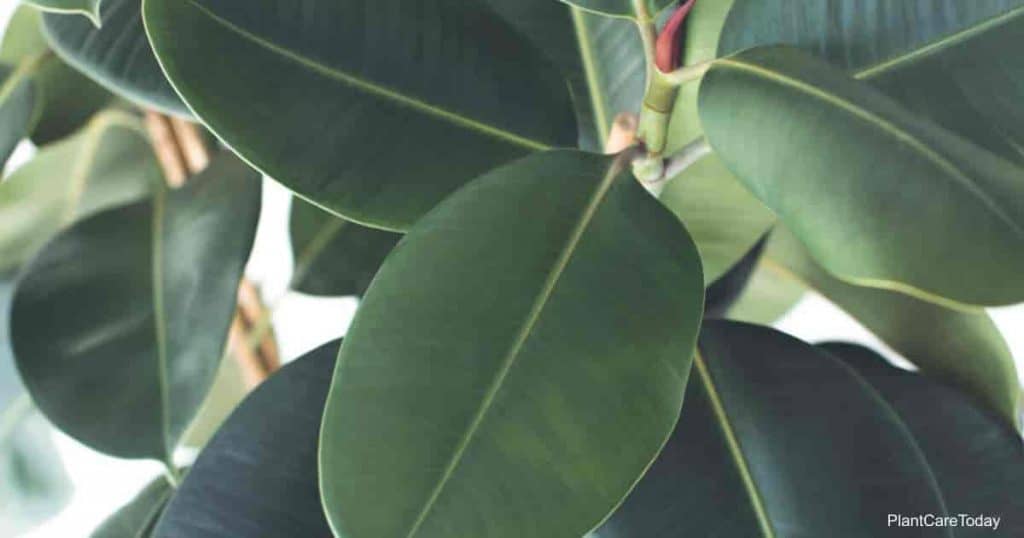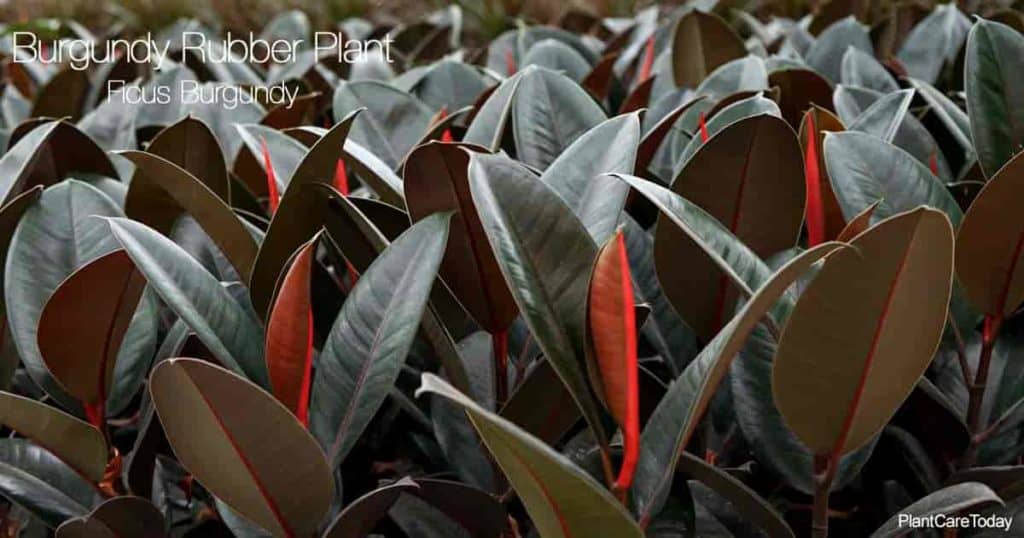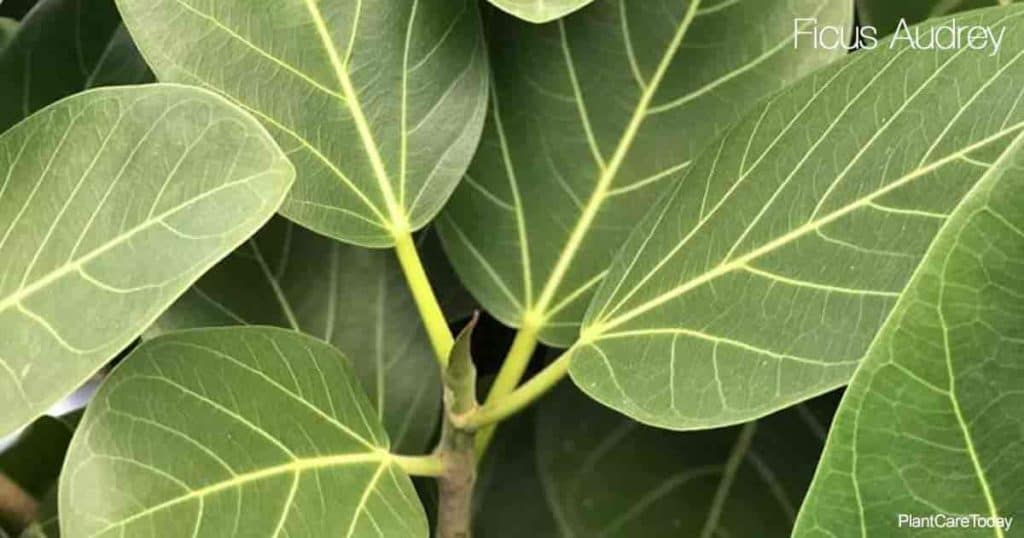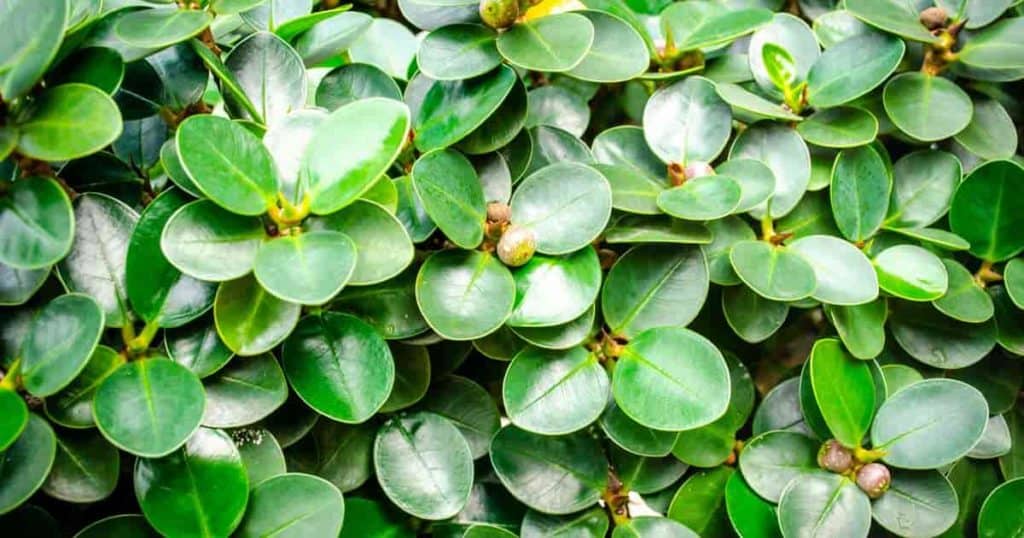Ficus plants [FYE-Kuss] include 800-1000 species of woody trees, shrubs, and vines from the Moraceae family. Many are grown as houseplants or outdoors in their native regions.

Ficus plants are native to tropical regions, but some species extend into subtropical areas. These regions include:
- Australia
- India
- East Asia
- Parts of the Mediterranean (Afghanistan to Portugal)
Ficus is Latin for “fig tree,” which makes sense given common fig trees are in the Ficus genus.
Let’s look at several ways to incorporate ficus plants in your home, garden, or landscaping project. Plus, we’ll also zoom in on ten of the most popular ficus species.
The Many Wonderful Features of Ficus
Species of Ficus vary from tall, forest-filling trees to trendy, ornamental plants.
Indoors, they are statement-making potted trees, often with gorgeous green leaves. Most are easy to care for, reaching between 5′ to 10′ feet tall indoors.
Since they lack a pollinator, the many types of indoor Ficus trees never fruit or flower. Outdoors, most Ficus will flower and develop fig-like fruits.
Some types of ficus plants have broad, flat leaves. Others bear drooping branches and small, ovular foliage.
These ficus trees are commonly trained to grow with braided stems or trunks and a prominent pom-pom-shaped burst of fluttery foliage at the top.

A few larger species have unique aerial roots that hang down from the treetops and anchor into the soil. The most popular is the Banyan tree.
If you happen to live in a tropical region, your Ficus might grow outdoors in direct sunlight. Most species are semi-drought-resistant and easy to grow.
Make sure you have space, though; some species can grow to well over 50′ feet tall.
Ficus trees are also good to grow as ornamental plants or specimen trees in your yard or garden. Because ficus trees are native to tropical and warm climates, they will only thrive in USDA hardiness zones 10 and 11.
What Are The Most Popular Types of Ficus Plants?
Here’s a rundown of the many popular types of Ficus plants, plus an overview of their key attributes.
Ficus Benjamina – Weeping Fig
The Ficus Benjamina is known as the common Weeping Fig. It’s a popular potted plant with long drooping branches and slender, glossy leaves.

Though it prefers bright light, it will adjust to shady spots.
If you move Benjamina around, expect leaves to drop. Don’t worry. It will grow new ones better equipped to handle the amount of light in its new location.
Different Types of Ficus Trees
There are several varieties of Ficus elastica (rubber trees) available. Green leaves, burgundy, and variegated leaves. Learn more about these types of rubber plant varieties.
Rubber Tree Plant: Ficus Elastica
Ficus Elastica is the common Rubber Tree Plant. These plants have large, stiff leaves, usually dark green. There are some variegated rubber tree varieties.

Interior designers refer to this plant as heavy because of its glossy, leather-like foliage. So it tends to look best in open spaces.
It’s also one of the easiest ficus trees to grow indoors in an artificial environment because it can tolerate the lower light conditions that are often common indoors while also handling the lower humidity that’s usually present inside.
There are a variety of uses indoors. Outdoors these plants grow very tall (upwards of 100′ feet tall) and often drop aerial roots. They look gorgeous in big, open spaces like public parks.
Ficus Robusta
Ficus robusta is also referred to as a Rubber Tree Plant or sometimes an Indian Rubber Tree. It looks like Ficus Elastica.
The leaves on Robusta are broader and stiffer than Ficus Elastica and stand more upright.
Ficus Decora
Ficus Decora also goes by the common name Rubber Tree Plant. It is a close cousin to Ficus Elastica and Ficus Robusta.
As its name suggests, the Ficus Decora is a favorite for home decor.
Its leaves are bigger and broader than Ficus Robusta and have a reddish central vein.
Ficus deltoidea
Mistletoe Fig (Ficus deltoidea) This species of ficus is native to Southeast Asia. It features bright-green, rounded leaves and grows as a tree or hemiepiphytic shrub in its native climate.

The mistletoe fig gets its name from the reddish-white berries the plant produces when it has ample sunshine.
These berries result in the plant resembling the famous plant used for kissing at Christmastime.
Red Leaf Fig (Ficus Congesta)
The red leaf fig is native to northeastern Australia, Indonesia, the Philippines, and Papuasia where it grows in rainforests, often along streams and creek beds.
Mature leaves are vibrant green in color and long (about 5″ to 10″ inches), and they sprout from branches in alternate patterns that look like rosettes when viewed from above.
Ficus Cyathistipula
(African Fig Tree) African Fig Tree is an evergreen, vigorously growing shrubby plant with glossy, leathery, tumbler-shaped, dark-green leaves arranged spirally on a 4 cm long petiole.
The figs are reddish when ripe and have thick, spongy walls which enable them to float on water.
Make sure the plant receives bright and indirect sunlight.
Ficus Burgundy – Burgundy Rubber Plant
Another close relative of the Ficus Elastica is the Ficus Burgundy or the Burgundy Rubber Plant. It’s also sometimes referred to as Abidjan.

This species has conspicuous dark red foliage that stands upright. It does well indoors, especially when kept in a warm and sunny location. The leaves turn almost purple under lower light conditions.
In Buddhism, the sacred fig tree is known as the “Bodhi Tree” and is considered to be the tree under which the Buddha attained enlightenment.
This tree thrives in Zones 8-10 but won’t produce edible fruit without the presence of the fig wasp to pollinate or manual pollination.
Other Popular Type Of Ficus Trees
Ficus Audrey – Ficus Benghalensis
The Ficus Audrey is a variety of Ficus Benghalensis, known for its fuzzy leaves. These leaves are large, pale green, and feature light veins running throughout.

Outdoors in their native India and Pakistan, these trees are some of the world’s largest, creating huge canopies for life to flourish.
Avoid exposure to bright and direct sunlight, as it can burn the leaves. Use well-drained soil and container with drainage holes to avoid overwatering.
Indoors, they grow somewhere between five and 10′ feet and make for stunning home decor.
Green Island Ficus – Ficus Microcarpa
Ficus Microcarpa goes by the common name Green Island Ficus, is a climbing shrub. It has small, round leaves that darken from yellow-green to emerald as they mature.

They’re a popular houseplant because they’re easy to care for and can tolerate low light conditions.
This one is low-maintenance, adaptable, and ideal for landscaping projects. It’s often used to create hedges outdoors and requires no pruning.
Indoors it looks like a small, potted shrub or bonsai and is considered very easy to grow.
Ficus Pumila – Creeping Fig
Ficus pumila, the creeping or climbing fig.

Its small, green, and ovular leaves darken in color as they mature. Some varieties feature variegated leaves with olive-green centers that fade to ivory edges.
Ficus Pumila is perfect for growing on walls.
It makes a beautiful houseplant, too, especially when kept in hanging pots. This allows its vine-like tendrils to dip over the sides.
Ficus Alii – Banana Leaf Fig – Ficus Maclellandii
The most common cultivar of the Ficus Maclellandi is Ficus Alii or Banana Leaf Fig. It has long, slender, banana-like leaves that are olive to dark green.

It’s a favorite amongst house plant enthusiasts because of its attractive look. Dense foliage hangs from drooping branches. Trunks are often spiraled or even braided.
Banana leaf figs do well outdoors, too, when placed in a warm and sunny location. Even there, though, they usually only grow to about twelve feet.
Ficus Pandurata – Ficus Lyrata – Fiddle Leaf Fig Tree
With large, deep-veined, violin-shaped leaves, the Ficus Pandurata or Fiddle Leaf Fig is a popular choice for home decor. It has bright green foliage and can grow up to ten feet tall.

It prefers warm, humid environments and in most locations, will do best indoors.
Though it may be the most trendy houseplant on the list, the Fiddle Leaf Fig also has a finicky reputation.
It likes filtered sunlight and can’t handle cold drafts. At the same time, it struggles if placed too close to indoor heat vents or in too much direct sun.
Ficus Triangularis

Ficus Triangularis is an interesting plant that gets its name from its triangular-shaped leaves. There is solid green and a variegated variety.
Ficus Altissima – Lofty Fig, Council Tree
A large, evergreen Ficus species are native to southeastern Asia. Ficus Altissima is somewhat epiphytic.
In its native home, it usually begins life growing in the branches of another type of tree. It quickly produces aerial roots and lots of foliage to smother out the host.
